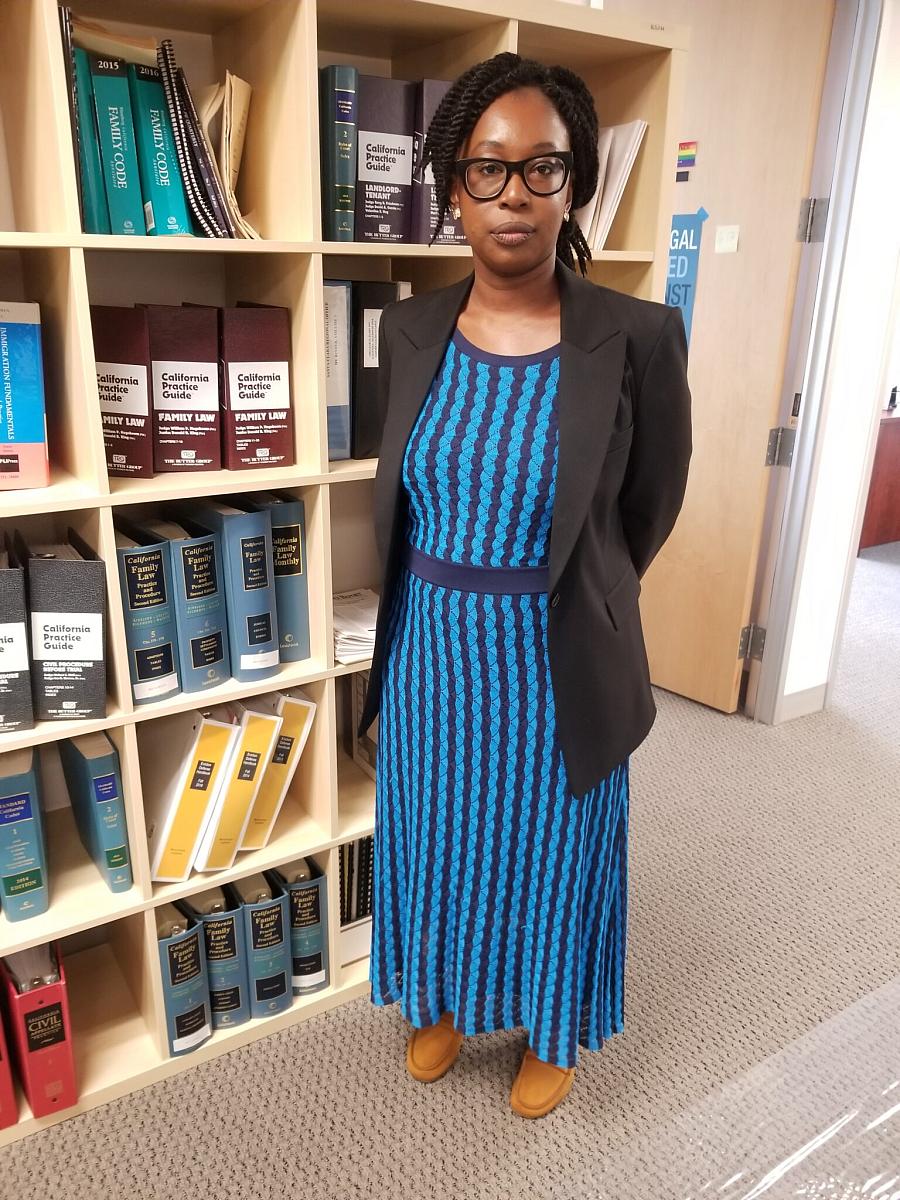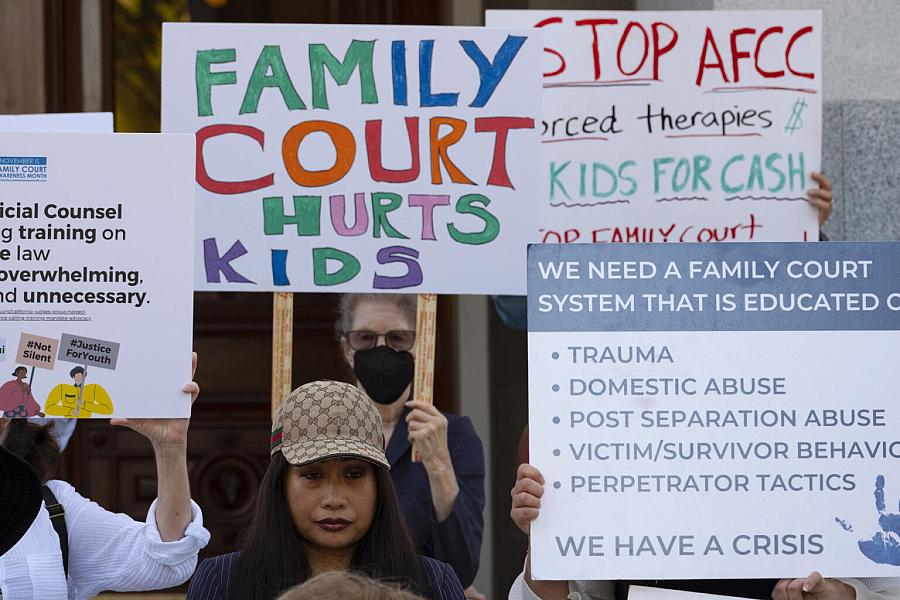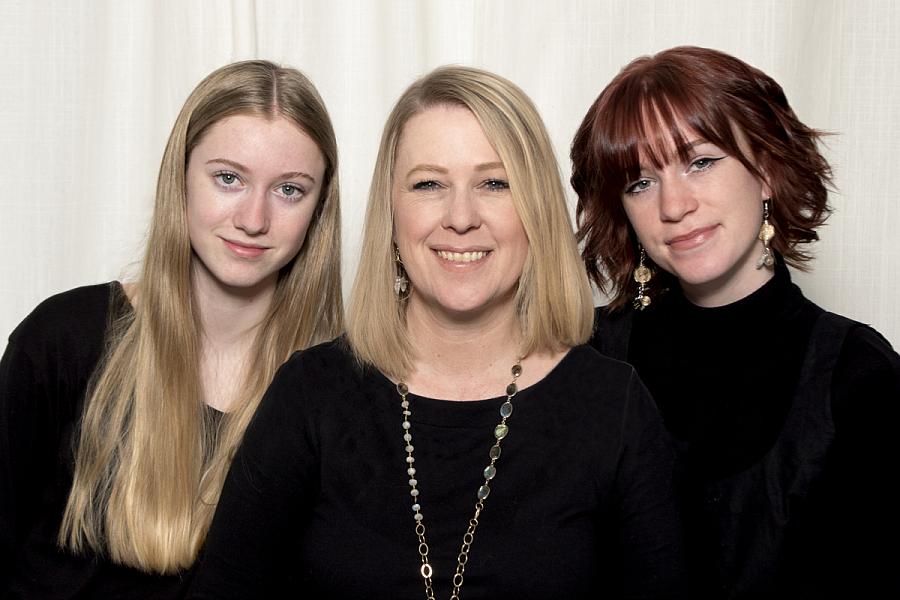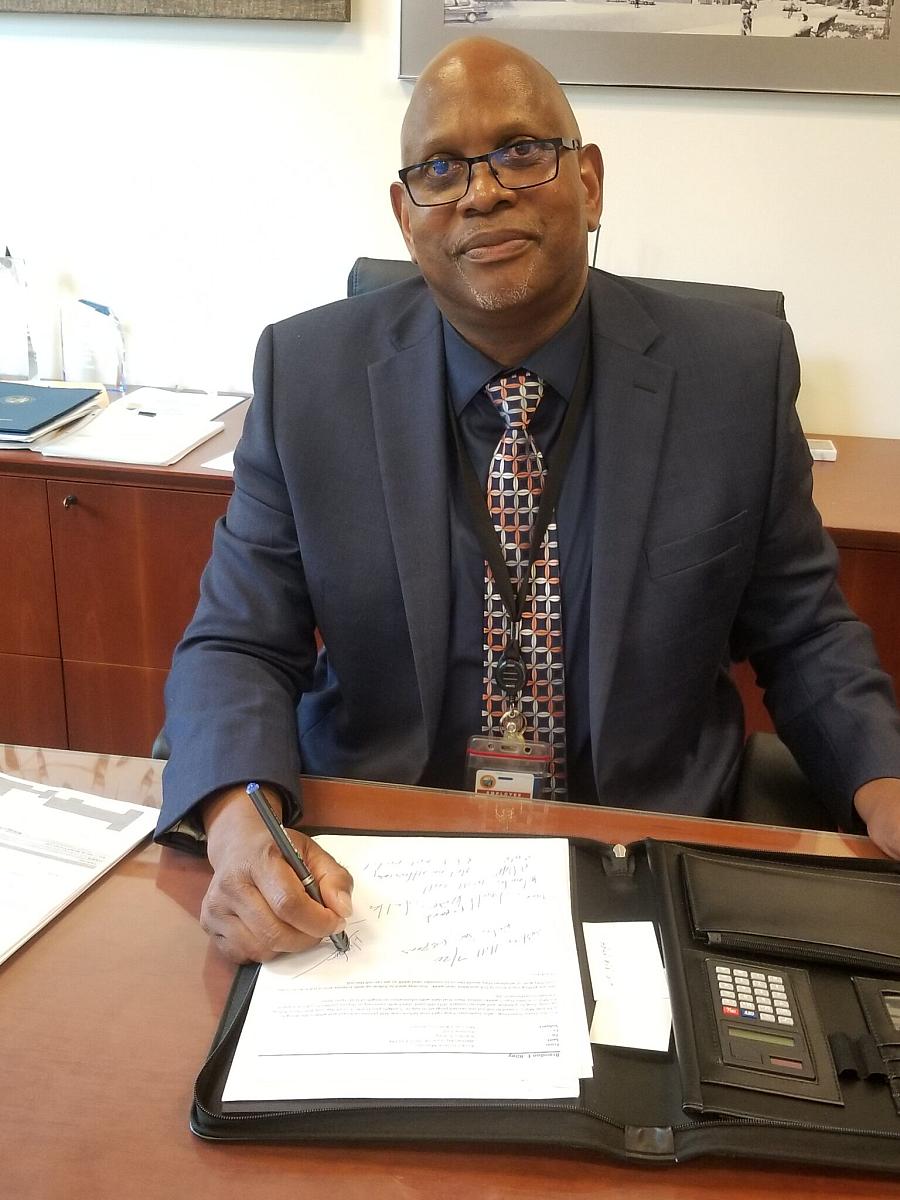California’s Court Reporter Shortage Limits Access to Justice in Domestic Violence Cases
The story was originally published in San Francisco Public Press with support from our 2023 Domestic Violence Impact Fund.

Michael Stoll/San Francisco Public Press
After arranging for her three children to be picked up from elementary school, taking time off from her nursing assistant job and battling nearly three-quarters of an hour of traffic, the 40-year-old woman entered the Santa Clara County Superior Court last October seeking a restraining order against her ex-husband.
To her surprise, the judge said no one was available to produce a transcript. Her choices were to proceed to trial, postpone by one day with no guarantee of a certified court reporter, or hire one privately. The third option was out of the question, since the service can cost up to $3,000 daily.
The next day, the woman — a Nigerian immigrant single mother who said she did not want her name used because she feared for her safety, so we are calling her Simone — showed up again. Once more, no court reporter.
Simone then realized she might not get what she was after: giving her husband only strictly supervised visits to their children. Her lawyers suggested that without a court reporter present, it might be better to settle with him.
Advocates for women’s and children’s rights say providing free or low-cost access to transcripts in hearings is key to equal justice. Unlike many states, California has in recent years repeatedly failed to guarantee adequate documentations of court proceedings, putting victims of domestic violence at a distinct legal disadvantage. In a state where many litigants attempt to represent themselves because they cannot afford to hire an attorney, lacking an official record creates a significant additional barrier.
Despite failing for years to make transcripts standard practice in California family courts, the Legislature may be headed for a breakthrough. State Sen. Susan Rubio, a Democrat from Baldwin Park, made incremental progress toward that goal in February with her bill, Universal Access to Court Records, which would allow recording in Superior Court hearings when certified court reporters are unavailable.
The legislation made it through the Senate Judicial and Business, Professions and Economic committees, but hit a roadblock in the Appropriations Committee, whose members asked Rubio for revisions. That kicked it into 2024 for further consideration.
Regardless of the delay, Rubio has not exactly been idle on domestic abuse issues. On Oct. 13, Gov. Gavin Newsom signed another bill she championed, Piqui’s Law, which prioritizes child safety in family court and promotes the training of judicial staff on child abuse and domestic violence issues. The law also bans courts from ordering so-called reunification therapy programs, a controversial approach that forces children to attempt to reconcile with parents with whom they have become alienated. This was Rubio’s second attempt in as many years to introduce this legislation.

State Sen. Susan Rubio has pushed for several reforms of family court, including Piqui’s Law. Supporters rallied with her at the state Capitol over the summer, and the governor signed the law in October.
Yesica Prado / San Francisco Public Press
But in many ways, solving the court reporter shortage would make a difference for a larger number of victims throughout the state.
“It’s such an important issue,” said Lorin Kline, director of advocacy at the Legal Aid Association of California, which co-sponsored Rubio’s court reporter bill. “Until we solve it, litigants will have their rights violated, with serious life consequences.”
Over the years, a number of California lawmakers have tried unsuccessfully to fix the court transcript gap through legislation lifting the state’s ban on electronic recording in civil and family law hearings in which court reporters are unavailable. While the state judiciary is statutorily required to provide reporters in felony criminal, juvenile justice and dependency cases, that does not apply for civil, family, probate, misdemeanor criminal and traffic law.
In 2013 and again in 2015, former Assembly member Donald P. Wagner, a Republican from Orange County, tried to expand electronic recording. In 2018, Assembly member Blanca Rubio, Democrat from Baldwin Park and Sen. Rubio’s sister, proposed allowing audio recording in civil courts. Her bill died in committee.
Wagner said pushback from the unions representing court reporters thwarted their efforts. Court reporters said they feared their jobs would be replaced by the likes of Alexa and Siri.
But experts have long expressed concern about labor organizations hindering reforms. Two decades ago, Glenn S. Koppel, a professor at Western State College of Law, wrote in the San Diego Law Review that the reporters union “maintains a powerful lobby in the California legislature that has blocked numerous efforts to introduce electronic court recording technologies in general jurisdiction proceedings.” Little has changed since then.
Court reporters counter that some proposed changes to the system could degrade the quality of the official record and discourage new entrants into the profession.
Court reporters are stenographers trained to create verbatim records of hearings primarily using stenotype machines. They lay the foundation for challenging rulings when litigants claim their civil rights are violated. Their absence can doom an appeal.

Attorney Kemi Mustapha of Bay Area Legal Aid, which represents many family court litigants.
Viji Sundaram / San Francisco Public Press
“It is virtually impossible to challenge a trial court order with an appeal, without a record of what witnesses and judges said in court,” said Sen. Rubio as she introduced her legislation Senate Bill 662.
Transcripts can also be used to review judicial behavior, sometimes revealing that a judge is insufficiently familiar with domestic violence law.
“Court reporters are one of the strongest tools to keep judges true to the letter of the law,” said Eric Riviera-Jurado, a staff attorney with the Sacramento-based nonprofit WEAVE — When Everyone Acts, Violence Ends. “Not having them in court allows judges to ride roughshod over low-income litigants.”
In California, litigants like Simone who file a fee waiver are entitled to a pro bono court reporter and transcript. The failure to provide one is a violation of a 2018 state Supreme Court decision that entitles low-income parties in civil hearings and trials to pro bono court reporters if they ask in a timely manner. Failing to provide one and waive fees, the court held, “effectively deprives such litigants of equal access to the appellate process.”
Simone’s attorney, Kemi Mustapha of Bay Area Legal Aid, said her request for a fee waiver for Simone was timely — she had made it almost three months earlier. And hers was not an isolated case. Her colleague Jenna Gottlieb had unsuccessfully made about a dozen court reporter requests for her own domestic violence clients in the span of a few months. “Only three were provided, and six times I didn’t get a response from the court,” Gottlieb said, adding: “I felt my hands were tied behind my back.”
The introduction of Rubio’s bill comes after the state last year lifted a ban on novel techniques allowing transcription by voice rather than keyboard, and almost two years after it increased annual funding to county courts by $30 million for new hires. But that program has been hard to implement.
Tussle over transcription
The court reporter shortage has spiked since 2012, when more than half of the 58 trial courts in California eliminated court reporters as a budget-cutting measure.
Many states faced with similar shortfalls have introduced electronic recording of Superior Court hearings. Today, California is in the minority of states by disallowing recordings in family, civil and probate courtrooms, according to Sarah Reisman, directing attorney of advocacy and litigation at Community Legal Aid SoCal.
But California also has the greatest demand for court reporter services in the nation, followed by two other large states that highly restrict recording, Texas and New York, said Jason Meadors, immediate past president of the National Court Reporters Association.
Meadors, who has been in the profession for 48 years, said court reporters, also known as certified shorthand reporters, are the gold standard. “There is no replacement for the human caretaker of the record,” he said. “If equipment fails, if there is a disruption to record making, whether by speakers or external factors, the stenographer, managing the record second-by-second, can take the steps needed to ensure an accurate record.”
Rubio said she was mindful that professionals might view her proposal as a job killer. But the bill stipulates that if a transcript from an electronic recording is requested, the court would first have to offer that work to a certified shorthand reporter.
The text of her bill underscores that the lack of access to recording technology is especially hard on low-income people, communities of color, Native tribes, people with disabilities, those with limited English proficiency and victims of domestic violence or sexual assault.
Eighty percent of family law litigants in the state represent themselves in court, according to the Judicial Council of California. But that is often a mistake, as navigating a system designed for attorneys can be stressful and legally perilous for the uninitiated.
“The proceedings in family court can be incredibly complex and fact intensive,” Reisman said at a breakfast meeting organized last April by the Los Angeles County Superior Court to highlight the court reporter shortage.
Changing standards, technology
For a domestic violence survivor fleeing an abusive relationship and seeking judicial remedies, obtaining a transcript could have a deeply personal impact, say women’s rights advocates. Without it, she could lose custody of her children, feel compelled to return to an abuser or even become homeless.
If enacted, Sen. Rubio’s bill will also loosen some of the stringent professional requirements that the California Reporters Association has long fought to protect. It is particularly difficult to get certified in California, according to a 2022 report prepared for the California Trial Court Consortium, an association of small judicial districts.
“Most states that mandate certification have only one exam required for licensure, but California has three,” the report said. “All three exams regularly yield low pass rates, but far more students fail dictation — the most specialized test — than pass. Moreover, the number of applicants attempting and passing the dictation exam has fallen in recent years.”
Rubio’s bill would allow people who pass the National Court Reporters examination to work in the field without passing California’s test. It would also allow judges to modify rulings relating to child custody or visitation when circumstances change. Without a transcript, it is nearly impossible to verify what the original circumstances were.
The state has taken another step to expand its court reporter pool. Last year, the Legislature lifted a ban on voice writing, in which reporters are trained to keep an accurate record by repeating the proceedings into a microphone and later preparing the verbatim transcripts. Federal and military courts have used them for years.
Not all court reporter schools in California have introduced a curriculum specifically for voice writing, but there are several online courses, according to the National Verbatim Reporters Association’s president Rebecca Bazzle. She said it takes only six to 12 months to become a voice writer, as opposed to three to four years to become a certified shorthand reporter. It took her organization nearly a decade to persuade California to lift the voice writing ban.
Custody of children
In previous years, Sen. Rubio has used her legislative position to move the policy needle on a number of domestic violence issues, including coercive control, a recently recognized category of abuse that does not necessarily involve physical abuse, but includes psychological or economic manipulation.

Protesters at a rally for Piqui’s Law supported additional education of judges and opposed reunification therapy, which they said forces children to reconcile with abusive parents.
Yesica Prado / San Francisco Public Press
Asked why having new technologies in court reporting mattered so much to her, Rubio cited the case of a Latina mother who fought for custody of her three children in the Sacramento County Superior Court in 2012. The woman, identified as C.S. in court records, was denied custody, and lost her request for a permanent restraining order against her husband. The trial court found that she had not provided enough evidence of abuse in a hearing, and failed to establish that it would not be in the children’s best interest to give their father custody. The father had an attorney, but the mother represented herself.
No court reporter was provided at her trial. She was probably unaware that if she wanted an official record, she would have had to request a fee waiver, said Jennafer Wagner, director of programs at the Family Violence Appellate Project, which provides free representation to domestic violence survivors in California and Washington state. The organization is a co-sponsor of Sen. Rubio’s bill-in-progress.
Lacking a transcript, the Appellate Project constructed a “settled statement” — a written summary based on the recollections of the parties and witnesses — and convinced California’s third district appeals court to hear C.S’s case. But the three-justice panel was not persuaded to overturn the trial court’s decision. “I do believe if we had an actual transcript, the outcome of the appeal would have been different,” Wagner said.
Sen. Rubio was not discouraged by the delay of her bill. In a recent interview, she said she would continue to fight for its passage because the lives of many women and children depended on it. “It just makes it a little more challenging,” she said.
The aftermath of domestic violence can leave women and their children experiencing a wide range of emotions, including fear, chronic pain and insomnia, research has shown. In some cases, it can be fatal, and physical, mental and behavioral health problems persist long after the conflict ends. Children who grow up witnessing violence at home can suffer a range of emotional disturbances.

Tina Swithin, center, blogged for years about her court struggle in San Luis Obispo County to get custody of her teenage daughters, Kailani, left, and Makena, right.
Angela Ferdig / One Mom’s Battle
“Family courts are the most important part of the judicial system, because its judicial officers hold children’s lives in their hands,” said domestic violence survivor Tina Swithin, who battled in the San Luis Obispo County courthouse for nearly 10 years, sometimes representing herself, before getting full custody of her two daughters, now 16 and 18. Swithin now runs One Mom’s Battle, a blog that has morphed into a worldwide movement with 225,000 followers.
Skilled labor shortage
Court stenographers are in high demand nationwide, but too few people are pursuing that career or graduating from training programs. Since 2012, the number of court reporters in the United States has dropped more than 20%. According to the Judicial Council, California employs about 1,200 full-time court reporters, but an additional 650 are needed.
Factors contributing to the nationwide shortage include reduced enrollment in training and the high rate of retirement, said the heads of California’s superior courts in a public letter last year, soon after Newsom signed the bill to allow voice writing.
California’s certified shorthand reporter shortage tops that of all other states, according to the National Court Reporters Association. Only eight training programs remain today, compared with 16 in 2011, wrote Michael Roddy, executive officer of the San Diego County Superior Court, in a January opinion piece in the San Diego Union Tribune. In 2021, 175 people took the licensing exam, and only 36 passed.

Brandon E. Riley, CEO of the San Francisco County Superior Court, has had to juggle reporters among courtrooms to avoid turning away low-income domestic violence survivors.
Viji Sundaram / San Francisco Public Press
Two years ago, the Legislature budgeted $30 million annually for courts to offer financial incentives to expand their pool of court reporters. Los Angeles County’s share was $10 million in each of the 2023 and 2024 fiscal years. San Francisco’s was $706,000.
But few jurisdictions have shown much success, forcing some to take drastic measures. In April 2022, Santa Clara County Superior Court stopped assigning court reporters in family law cases, except in emergency restraining order hearings.
The effect of the shortage is so severe in Los Angeles County, home to the largest trial court in the nation, that in just the first two months of this year 52,000 hearings took place without a court reporter, including 14,052 family law hearings, said David Slayton, who became court executive officer there last December. In an email, Slayton said that if the situation persists, his court might not be able to provide reporters even in mandated cases.
Up until now, all family law litigants in domestic violence cases who requested fee waivers have been provided court reporters, he said. But he said that, less than ideally, “in some instances parties to domestic violence and restraining order hearings may opt to move forward with their cases without a court reporter” — a choice unlikely to result in desired outcomes.
Despite impressive financial incentives for workers and massive advertising, Slayton said he was able to hire eight court reporters since February, but eight retired in the same period, “resulting in a zero net gain.”
Brandon E. Riley, head official of the San Francisco County Superior Court, said his court was “pretty close to the edge of the cliff.” Despite three years of recruitment efforts, the court has only 26 reporters to fill 40 slots in its 52 courtrooms.
Since taking over in April, Riley said he had to juggle reporters among courtrooms to avoid turning away low-income domestic violence survivors. He said he hoped to expand the court reporter pool with a new daily fee of $1,000, and by increasing the retention offer — bonus pay to keep workers in their positions — to $30,000 over three years, up from the current $10,000. Among other creative solutions he is considering is hiring voice writers, like Santa Clara County Superior Court recently did.
Prohibitive costs
Part of the challenge for recruiting and retaining court reporters nationwide is being able to pay wages competitive with the private sector. Court reporters nationally earn an average of $62,000, but command considerably more in private companies. San Francisco pays the highest court reporter salary in the state — $150,000 plus benefits. “If you get past the exam, it’s a lucrative career to work in a court,” Riley said.
Alaska has not used court reporters since achieving statehood in 1959, opting instead for audio recording. In Nevada, judges are given the option of having a stenographer or a recording, and most opt for the latter, said Mark Gibbons, who served as a trial court judge there and later in that state’s Supreme Court until his retirement in 2020.
Gibbons said that while electronic recording technology has improved, once in a while the equipment stops briefly. “Even two or three minutes of a gap could mean missing very important testimony,” that cannot reliably be re-created, he said. “When that happens, the appellate court will decide the case the best it can, unless the lawyers for all parties stipulate to what was testified to.”

Los Angeles Superior Court has turned to electronic recording to compensate for the court reporter shortage.
Angela Ferdig / One Mom’s Battle
But Janet Harris, president of the American Association of Electronic Reporters and Transcribers, said that certified reporters are trained to ensure that such gaps are avoided because they are monitoring the equipment throughout the proceeding.
“In the event of a problem, the certified digital reporter is trained to immediately stop the proceeding so there is no loss of record,” she said. If audio gear is properly maintained and tested, she said, gaps can be avoided.
“Electronic recording equipment has proven very reliable,” Los Angeles County’s Slayton said. “In fact, in 2022, over 500 appeals of matters in evictions, criminal cases and other limited jurisdiction matters were electronically recorded, reviewed and decided by our Appellate Division without incident.”
Still, any move to introduce recording in California’s 58 counties will likely continue to face opposition from unions. David Green, president of SEIU 721, which represents court reporters in Los Angeles and the Inland Empire, said in an interview last year that if the state “tries to replace shorthand reporters with digital devices, we will push back.” He declined to comment on Sen. Rubio’s latest attempt.
Women’s rights advocates are determined to get Rubio’s bill on the governor’s desk next year. They say domestic violence survivors need those transcripts to get justice.
“We are hopeful the Senate Appropriations Committee will recognize the urgency of this issue and its impact on low-income and self-represented litigants and act to pass SB 662 out of committee before their January 2024 deadline,” Slayton said.
In the meanwhile, legal aid lawyers continue to prepare their clients for finding no court reporter when they arrive in family court.
Simone, the Nigerian mother, decided to take Mustapha’s advice and settle with her abusive ex-spouse. The judge awarded her a three-year restraining order and full custody of the children, all less than 10 years old.
She said she was disappointed that her ex was given unsupervised visitation rights. She had hoped for an outcome that would have given him only restricted contact with the kids.
“A lot of women from Africa,” Simone said, “would hesitate to publicly speak up about the domestic violence they experienced, because of the stigma.”
But had a trial happened, she said, she would not have held back about the details of the abusive behavior that ripped her family apart.

